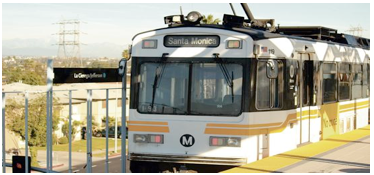Crenshaw Line: Confronting the Parking, Barking and Marking Issues
TRANSIT TALK--Moving forward from the past to the future is something I advocate for everyone--memory is critical, but forcing one's self to keep focused on the future is just as important. In my last CityWatch article, I adamantly pronounced my support for the Expo Line, but also raised a few points about the Expo Line being a good neighbor--the time it took to travel from one end of the line to the other was questionable, parking was in insultingly short supply, and bus/Uber/Lyft/rider amenities were also behind where they need to be.
As the expression goes, "time will tell" whether the 50-55 minutes from one end of the line is accurate, or whether the 46 minute Downtown LA to Downtown Santa Monica timeframe that Metro reports is accurate. But seven new stations and more access to both Downtowns, as well as the Mid-City and Culver City destinations along the way, can only be a good thing.
Yet Metro also proclaims that the Expo Line is an alternative to the I-10 freeway, and so the issues of insufficient parking on the Expo Line raised by the LA Times and others threaten the perception of the benefits of the Expo Line, and even threaten whether more transit/transportation funding will pass in this November's proposed sales tax initiative if the Expo Line leaves a sour taste in taxpayers' mouths.
Pity.
And perhaps it's just unfair to quote the Times article when one Suja Lowenthal (who may, as the press so often does, have been quoted out of context), the planning and engagement manager for the award-winning and nationally-respected Big Blue Bus, says, "Part of the excitement of rail is figuring it out and having some uncertainty."
Well, no ... not really. Not at all. Uncertainty for most people is very, very BAD.
Having insufficient parking … 544 spaces … for a line supposed to be an alternative to the I-10 freeway, and for a line supposed to carry tens of thousands of commuters a day? Really?
That's akin to building a new or upgraded freeway without onramps and offramps and telling people that it's great they'll have the challenge to access the billion-dollar transportation project they paid for.
So let's both celebrate the decades-long pursuit and success of the Expo Line while also advocating for changes and upgrades to make it a success to the majority of those who pursued and fought for it.
And as we celebrate the halfway point of the Crenshaw/LAX Line let's not forget what's necessary to make that line a success, as well.
Let's confront the Parking, Barking, and Marking issues, shall we? Please? Pretty please?
1) PARKING: Again, the Expo Line is supposed to be an alternative to the I-10 freeway, and we've got no car to train Metrolink in the region. This isn't quite the same as the Crenshaw/LAX Line, but any freeway-adjacent station on either line needs parking for the widespread Southern California commuter base to access our urban/dense cores.
So taking advantage of the two main Westside "regional" stations at Exposition/Sepulveda and Venice/Robertson is not a kooky, naive, or uninformed idea. It's common sense.
We've got a no-build, non-residential "dead zone" near the Casden project adjacent to the 405 freeway that's itching for a Regional Transportation Center (with parking, bus/van and bicycle amenities) to include hundreds of parking spaces. We've also got the need for a similar center on the Los Angeles side of the Venice/Robertson station, and having Culver City do the job of Los Angeles for its residents isn't acceptable.
Or do we just have to wait for Councilmembers Paul Koretz and Herb Wesson to be termed out of office in order for them to be FOR something with respect to their constituents on this issue? The parking need not, and SHOULD not, be free, but dumping Expo Line commuter-focused parking on adjacent neighborhoods is just wrong on so many levels. Make it easy, make it affordable, and make it fair for all parties involved.
And if the Expo/Crenshaw station and the Hindry/Westchester stations need it on the Crenshaw Line, as well as any South Bay Green Line stations once that line connects to LAX, then so be it. Just DO what the taxpayers and commuters want, OK? Is it so hard to listen to your constituents?
2) BARKING: We've heard from the NIMBY's, the race-baiters, and the haters, about how this Expo Line will cause problems and how it's all about them. To some degree, we've seen this about the Crenshaw/LAX Line as well, what with race and civil rights issues misused aplenty when simple transportation/planning, urban redevelopment, economic enhancement and environmental planning should have been the main focus.
What we've not heard enough from are the greater voter electorate. Most of the communities want an east-west Expo Line and north-south Crenshaw/LAX line...period. They want it to enhance the economy, mobility, environment, and quality of life for the majority of residents and commuters who's use and/or benefit from these lines.
They want the businesses preserved, more parking built if the neighborhoods and businesses cry out for it, and they want these lines to be safe, clean, and convenient for people of all ages, races, and backgrounds...and they don't want any litany of excuses on why that can't be done.
This is true from the Westside to the Mid-City to Downtown, and from the Wilshire District to the Mid-City to the South Bay. They're all happy to see new projects succeed...but the constant barking from the usual suspects needs to be addressed when it becomes clear that those barking are IN THE MINORITY. Listen to all parties, and if the MAJORITY wants something contrary to the MINORITY, please follow MAJORITY RULE.
3) MARKING: Things will change that will "blow everyone's mind". When the Downtown Connector is completed by 2022-23, and the Crenshaw/LAX Line is also completed, there will be several north-south lines that require renaming. And future lines will need highlighting.
a) Will the east/west Exposition/Eastside Light Rail Line become one big Gold Line?
b) Will the north/south Blue Line and Pasadena (and connecting Foothill) Gold Line become one big Blue Line?
c) Will the east-west Green Line to LAX...and beyond to the Westside become one big Green Line, or shall it be renamed?
d) Will the north-south Crenshaw/LAX Line and the South Bay segment of the Green Line become one big new line, with a future color to be named (or shall it be the Green Line)?
e) When we talking about finishing the Crenshaw Line, does that mean expanding it north to the Wilshire/Purple and Red Line subways, or creating a new wing from Inglewood to the Blue Line and Downtown via the Harbor Subdivision Rail Right of Way, or both?
Let's celebrate this weekend's new light rail line. Let's celebrate grassroots advocacy and government leadership.
But let's not rest on any laurels while there's so much work, discussion, and leadership that glaringly remain in order to create the Exposition and Crenshaw/LAX Lines we all know, in our hearts and minds, that we all fought for...and which we deserve to have.
(Ken Alpern is a Westside Village Zone Director and Board member of the Mar Vista Community Council (MVCC), previously co-chaired its Planning and Outreach Committees, and currently is Co-Chair of its MVCC Transportation/Infrastructure Committee. He is co-chair of the CD11Transportation Advisory Committee and chairs the nonprofit Transit Coalition, and can be reached at [email protected]. He also co-chairs the grassroots Friends of the Green Line at www.fogl.us. The views expressed in this article are solely those of Mr. Alpern.)
-cw









 Despite law enforcement's extensive training and new resources, the problems of homelessness and mental illness are vast. Last year, Los Angeles County District Attorney Jackie Lacey presented a comprehensive plan to the Board of Supervisors that recommends enhanced treatment and services to safely divert mentally ill offenders from the county jail. In Los Angeles, the Sheriff's Department and the LAPD are constantly collaborating with the various public and private sector organizations to better address the behavior of mentally ill individuals. However, at the end of the day, it is the community of Los Angeles that must demand of our elected leaders at both the state and local level a comprehensive plan to combat the true roots of homelessness.
Despite law enforcement's extensive training and new resources, the problems of homelessness and mental illness are vast. Last year, Los Angeles County District Attorney Jackie Lacey presented a comprehensive plan to the Board of Supervisors that recommends enhanced treatment and services to safely divert mentally ill offenders from the county jail. In Los Angeles, the Sheriff's Department and the LAPD are constantly collaborating with the various public and private sector organizations to better address the behavior of mentally ill individuals. However, at the end of the day, it is the community of Los Angeles that must demand of our elected leaders at both the state and local level a comprehensive plan to combat the true roots of homelessness. 
 No, they clearly won't--and what they'll do is drive to the Venice/Robertson or La Cienega stations, where there is parking that's now occupied by 8-9 am, and where Downtown-bound traffic bunches up on the I-10.
No, they clearly won't--and what they'll do is drive to the Venice/Robertson or La Cienega stations, where there is parking that's now occupied by 8-9 am, and where Downtown-bound traffic bunches up on the I-10. 

























